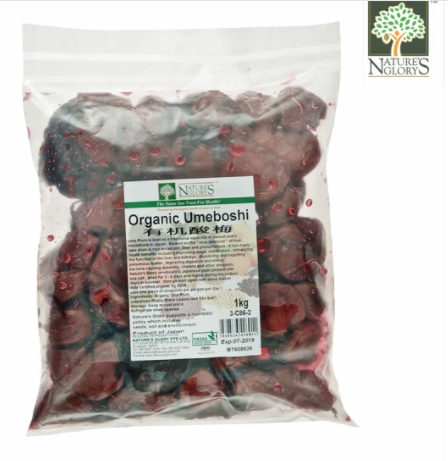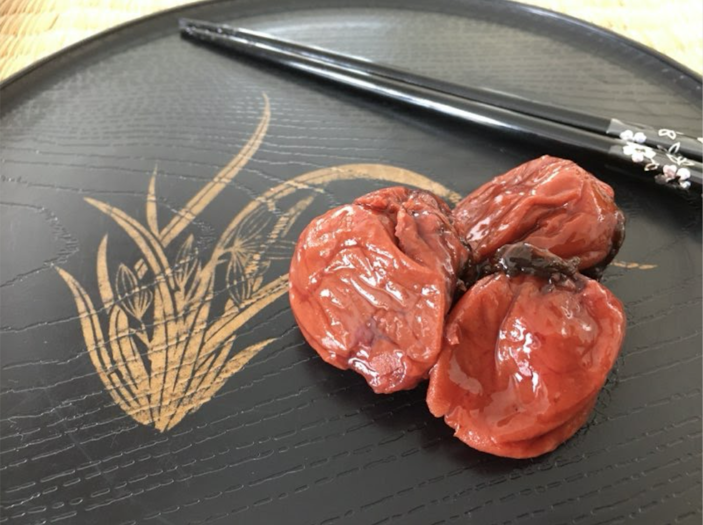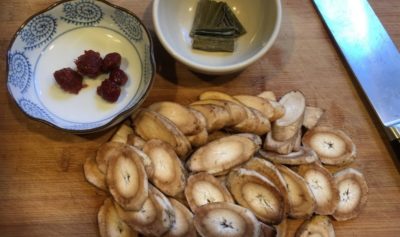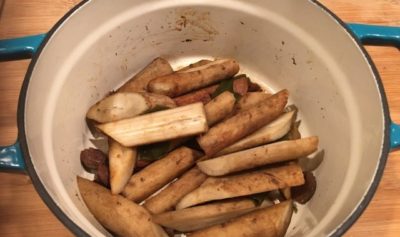In traditional Japanese culture, the equivalent of the apple a day keeps the doctor away is the umeboshi plum. Today, people still regard these amazing umeboshi plums as an ancient power food.
The ancient folks highly revered these amazing umeboshi plums for their wide-ranging medicinal values. Today, many people value these small preserved plums for their culinary qualities.
Pickled umeboshi plums come from the fruit of Prunus mume. This is actually an Asian species of apricot. But it is more commonly called a plum.
The fruits are picked at the end of June when they are green and unripe. This is when the plums are at the peak of their acidity. Pickling process requires salt. Then add the salt and shiso leaves or beefsteak. Shiso is a medicinal herb that gives the pickled umeboshi plum its distinctive red color.
The plums are then aged for a year or longer, until they become small and shriveled with a reddish hue from the shiso leaves. Due their high citric acid content, the picked umeboshi plums taste salty and sour.
Using the Plums
The earliest reference to the salty umeboshi plums dated back to the 10th century. Research shows that the use of the plums originates from China more than 2,000 years ago.
Culinary and therapeutic uses of the plums spread to Japan. And for centuries, the Japanese have been eating these preserved plums.
In traditional Japanese societies, everyone ate the umeboshi plums. Daimyo, sumo wrestlers, and samurais would eat umeboshi plums to overcome battle fatigue.
Today, people eat umeboshi plums in a variety of ways. You can use umeboshi plums in dressings, dips, and sauces to enhance flavor in various dishes. The sourness of the plums whet one’s appetite.
Benefits of the Amazing Umeboshi Plums
This ancient food has powerful healing properties and help balance pH and strengthen the body.
Umeboshi plums are beneficial for many different conditions. The plums help with various gastrointestinal troubles, bad breath, constipation, diarrhea, indigestion, lack of appetite, nausea, and vomiting.
They are great for easing many different kinds of fluid discharge. For instance, runny nose, excessive urination or perspiration, and heavy menstrual periods.
Umeboshi plums make a good natural home remedy for bacterial and viral infections. They are one of the most alkalinizing foods. Hence, it helps restore the body’s acid-alkaline balance.
When our blood and body fluids are naturally slightly alkaline, we are in good health. However, illness and infections thrive when the body condition becomes too acidic.
Amazing Umeboshi Plums Anecdotes
I’d like to share a few amazing umeboshi plums stories.
A friend of mine stated that he once managed to quell a mild asthma attack with an umeboshi plum. Within 15 minutes, his breathing difficulty eased and he was able to breathe normally again.
This friend understood the yin and yang nature of foods. Ice cream is yin; umeboshi plums are yang. He had eaten too much ice cream that day, which upset his body, triggering a mild asthmatic response.
Upon realizing the situation, my friend countered the yin situation by popping a plum in his mouth. But I never found out if he had to eat the entire salty plum as well.
Another unusual story shows how this amazing umeboshi plums could function as a mosquito repellent.
A macrobiotic teacher from the European Kushi Institute told the story about his visit to Africa. He slept with the windows wide open at night—but with an umeboshi in his mouth. And the mosquitoes didn’t bother him at all, he said.
A Personal Story
Here’s my own experience with the amazing umeboshi. It’s after a heavy snowfall. I decided to put the umeboshi plum to the test myself.
Before going out to shovel snow from the driveway after a snow storm, I placed an organic umeboshi plum in my mouth.

The effect was amazing, if not surprising. I felt like an ancient Japanese samurai who conquered fatigue with a single umeboshi plum in my mouth!

For nearly two hours, I was shoveling all that snow, feeling strong, centered, and grounded from my Hara (in Japanese) or lower Dantian (in Chinese).
According to ancient Chinese medicine, the human body has a network of meridians (or energy pathways) with numerous acupoints. One of the major acupoint is called the lower Dantian, also known as the “Sea of Qi,”
This point is just below the navel. It is the source or reservoir of vital energy (Yuan Qi). Hence, the lower Dantian is the vital energy centre of the human body. It is also the center of gravity point, crucial in Chinese and Japanese martial arts, or qigong practices.
Buying Tips
When you buy umeboshi plums, make sure you read the label carefully. Many commercially made umeboshi plums contain sugar, MSG, preservatives, and other unnatural ingredients. Do not buy plums with these unnatural ingredients.
Commercial plums may taste nice and sweet. But their healing properties are not as potent as the umeboshi plums made using traditional methods and without artificial additives.
Of course, it is best to use organic umeboshi plums.
Where to Buy

You can buy these amazing umeboshi plums from health and whole foods stores or online.
But, most plums come in small packets.
The only place I know that sells organic umeboshi plums in one-kilogram packets is Nature’s Glory in Singapore.
Check out my articles on umeboshi plums.
- 9 Ways to Enjoy Umeboshi Plums
- 10 Ways to Use Umeboshi Plums
- Kinpira-style Burdock Umeboshi Stew
Note: These natural food tips, traditional remedies, and anecdotes are for maintaining your health and wellness. They are not meant to replace any medical treatment. If you have a diagnosed condition, or are in doubt, you should always seek medical advice.
 Dr. Margaret TreyAuthor, Researcher & Wellness Advocate
Dr. Margaret TreyAuthor, Researcher & Wellness Advocate






